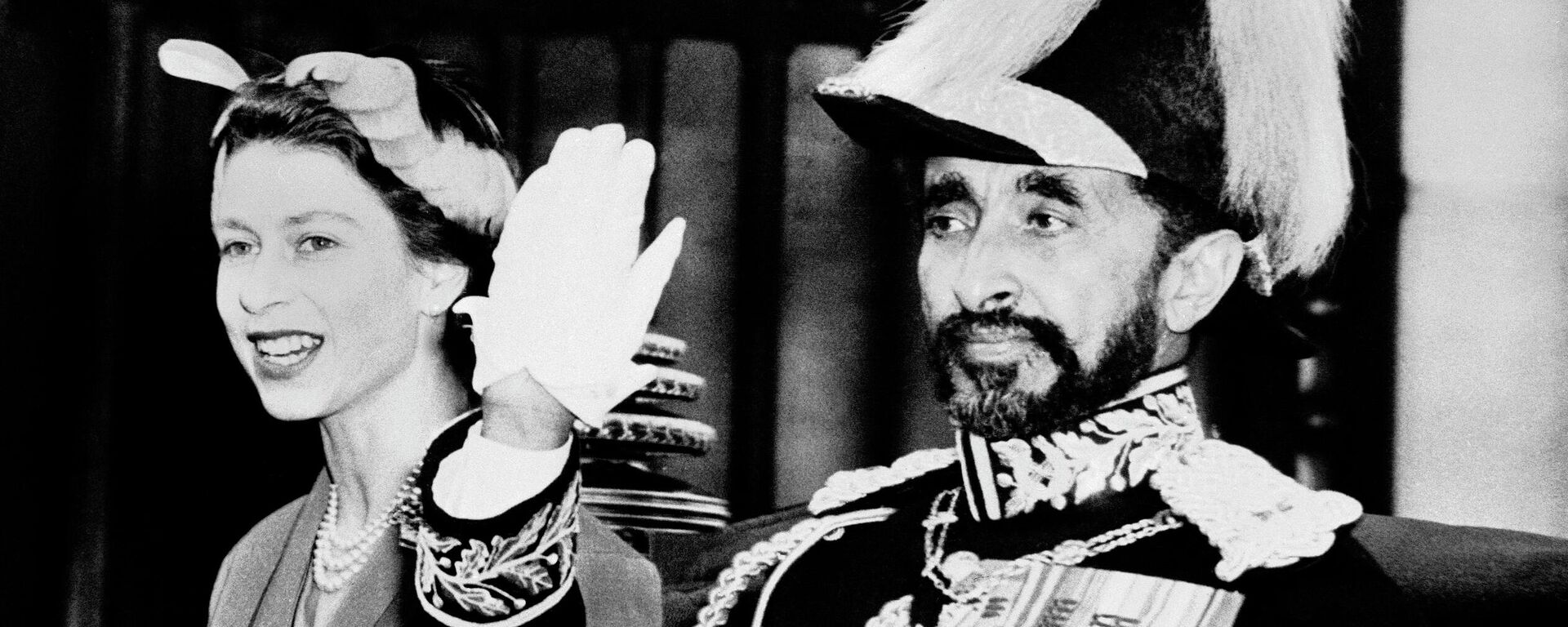https://en.sputniknews.africa/20231102/haile-selassies-coronation-day-how-did-ethiopian-emperor-become-god-of-rastafari-1063266995.html
Haile Selassie's Coronation Day: How Did Ethiopian Emperor Become God of Rastafari?
Haile Selassie's Coronation Day: How Did Ethiopian Emperor Become God of Rastafari?
Sputnik Africa
The idea of a Rastafari immediately conjures up images of the charismatic reggae master Bob Marley and his head of twisted dreadlocks. Marley is certainly a... 02.11.2023, Sputnik Africa
2023-11-02T18:08+0100
2023-11-02T18:08+0100
2023-11-02T18:08+0100
features
international
haile selassie
jamaica
ethiopia
culture
history
east africa
https://cdn1.img.sputniknews.africa/img/07e7/07/17/1060717546_0:367:2988:2048_1920x0_80_0_0_4dcd3ce62103349c110e0c1a6a8d0b16.jpg
Thursday marks one of the holiest days of the Rastafarian year, celebrating Haile Selassie's ascension to the Ethiopian throne on November 2 and reinforcing Ethiopia's role at the heart of the Rastafarian tradition.Haile Selassie I, or Ras Tafari before his coronation, came to power as regent of Ethiopia in 1916 after ousting his cousin Lij Yasu, who had converted to Islam and alienated the country's mostly Christian population.Among followers of Rastafarianism, a religion that developed in Jamaica in the 1930s under the influence of Marcus Garvey's Back to Africa movement, Haile Selassie I is seen as a messiah, God incarnate, or Jah, who manifested in human form to lead the people of Africa and the African diaspora to freedom.The movement was named in honor of the emperor's name given to him at birth, and the red-yellow-green flags of Ethiopia have become the attributes of members of the subculture.Where did the prominence of the Ethiopian emperor derive from?It is unclear whether the "black king" referred to was a real person or a symbolic figure, but when news reached Jamaica in 1930 of Haile Selassie's coronation, who claimed descent from the biblical King Solomon and the Queen of Sheba, many of Garvey's followers made the logical connection.Christianized people of Jamaica, which remained a British colony until 1962, drew hope for a better life from the prophecies and began to see Selassie as a savior and Ethiopia as a free country because it was the only African country (besides Liberia) that had never been colonized.The first Rastafarian communities emerged in eastern Jamaica around 1931, and the first two generations of Rastafarians were predominantly of working-class African descent, according to researchers.Over time, they began to interpret the Bible to mean that black people were given into slavery by Jah to white people (Europeans and their descendants who colonized Africa) as punishment for their sins, and must live under the oppression of Babylon, a modern socio-political system based on Western values, waiting for the coming of Jah Selassie to free them and take them to "paradise on earth" – Ethiopia.Selassie died under mysterious circumstances on August 27, 1975, while under house arrest at the Grand Palace in Addis Ababa. The emperor was believed to have been assassinated by the coup authorities, who took power in 1974. The military, however, claimed that the detained monarch died of respiratory failure.But his memory lives on, for every year, Rastafarians, with an estimated 700,000 to 1,000,000 members, honor the day of his accession to the throne with large gatherings of singing, chanting, drumming, worship and reflection.
https://en.sputniknews.africa/20230723/haile-selassies-131st-birthday-how-does-world-remember-ethiopias-last-emperor-1060712947.html
jamaica
ethiopia
east africa
Sputnik Africa
feedback@sputniknews.com
+74956456601
MIA „Rossiya Segodnya“
2023
Maxim Grishenkin
https://cdn1.img.sputniknews.africa/img/07e7/0a/17/1063018107_0:0:1104:1103_100x100_80_0_0_03090c85a11f5d2e8a19cf1d989443c9.jpg
Maxim Grishenkin
https://cdn1.img.sputniknews.africa/img/07e7/0a/17/1063018107_0:0:1104:1103_100x100_80_0_0_03090c85a11f5d2e8a19cf1d989443c9.jpg
News
en_EN
Sputnik Africa
feedback@sputniknews.com
+74956456601
MIA „Rossiya Segodnya“
Sputnik Africa
feedback@sputniknews.com
+74956456601
MIA „Rossiya Segodnya“
Maxim Grishenkin
https://cdn1.img.sputniknews.africa/img/07e7/0a/17/1063018107_0:0:1104:1103_100x100_80_0_0_03090c85a11f5d2e8a19cf1d989443c9.jpg
international, haile selassie, jamaica , ethiopia, culture, history, east africa
international, haile selassie, jamaica , ethiopia, culture, history, east africa
Haile Selassie's Coronation Day: How Did Ethiopian Emperor Become God of Rastafari?
The idea of a Rastafari immediately conjures up images of the charismatic reggae master Bob Marley and his head of twisted dreadlocks. Marley is certainly a Rastafari icon who popularized the message of the subculture, but there is another man at the heart of the Jamaican movement.
Thursday marks one of the holiest days of the Rastafarian year, celebrating Haile Selassie's ascension to the Ethiopian throne on November 2 and reinforcing Ethiopia's role at the heart of the Rastafarian tradition.
Haile Selassie I, or Ras Tafari before his coronation, came to power as regent of Ethiopia in 1916 after ousting his cousin Lij Yasu, who had converted to Islam and alienated the country's mostly Christian population.
Among followers of Rastafarianism, a religion that developed in Jamaica in the 1930s under the influence of Marcus Garvey's
Back to Africa movement, Haile Selassie I is seen as a messiah, God incarnate, or Jah, who manifested in human form to
lead the people of Africa and the African diaspora to freedom.
The movement was named in honor of the emperor's name given to him at birth, and the red-yellow-green flags of Ethiopia have become the attributes of members of the subculture.
Where did the prominence of the Ethiopian emperor derive from?
“Look to Africa when a black king shall be crowned, for the day of deliverance is near.” This prophecy by Marcus Garvey, a Jamaican political activist, in the 1920s foreshadowed the cult of Selassie.
It is unclear whether the "black king" referred to was a real person or a symbolic figure, but when news reached
Jamaica in 1930 of Haile Selassie's coronation, who claimed descent from the biblical King Solomon and the Queen of Sheba, many of Garvey's followers made the logical connection.
Rastafarians believe that the visit of the Queen of Sheba to King Solomon, described in the Book of Kings (3 Kings 10:1-13), is a proof of Haile Selassie I's divinity, as the queen supposedly conceived a child with the king. That child is considered to be in the same line of descendants as Haile Selassie I.
Christianized people of Jamaica, which remained a British colony until 1962, drew hope for a better life from the prophecies and began to see Selassie as a savior and Ethiopia as a free country because it was the only African country (besides Liberia) that had never been colonized.
The first Rastafarian communities emerged in eastern Jamaica around 1931, and the first two generations of Rastafarians were predominantly of working-class African descent, according to researchers.
Over time, they began to interpret the Bible to mean that
black people were given into slavery by Jah to white people (Europeans and their descendants who colonized Africa) as punishment for their sins, and must live under the oppression of
Babylon, a modern socio-political system based on Western values, waiting for the coming of Jah Selassie to free them and take them to "paradise on earth" – Ethiopia.
One of the most significant events in Rastafari and Jamaican history was the visit of Emperor Haile Selassie to the island on April 21, 1966. Haile Selassie was greeted by a huge crowd of over 100,000 Rastafarians and other Jamaicans who gathered at Kingston Airport to see the Ethiopian Emperor.
Selassie died under mysterious circumstances on August 27, 1975, while under house arrest at the Grand Palace in Addis Ababa. The emperor was believed to have been assassinated by the coup authorities, who took power in 1974. The military, however, claimed that the detained monarch died of respiratory failure.
But his memory lives on, for every year, Rastafarians, with an estimated 700,000 to 1,000,000 members, honor the day of his accession to the throne with large gatherings of singing, chanting, drumming, worship and reflection.



